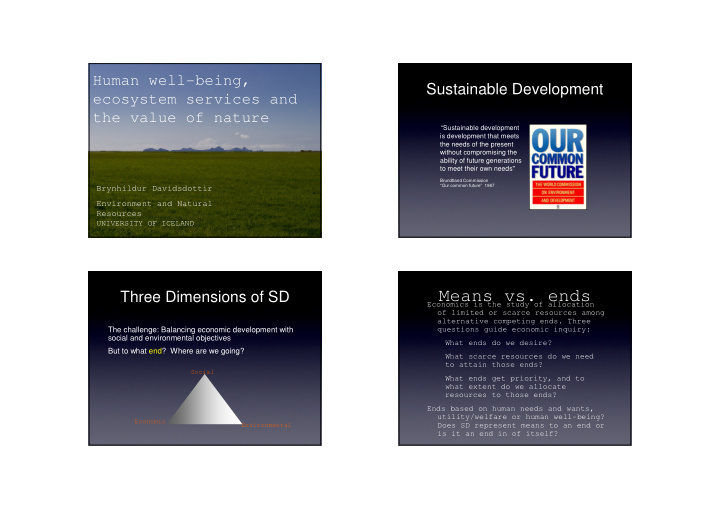



Human well-being, Sustainable Development ecosystem services and the value of nature “Sustainable development is development that meets the needs of the present without compromising the ability of future generations to meet their own needs" Brundtland Commission “Our common future” 1987 Brynhildur Davidsdottir Environment and Natural Resources UNIVERSITY OF ICELAND Means vs. ends Three Dimensions of SD Economics is the study of allocation of limited or scarce resources among alternative competing ends. Three The challenge: Balancing economic development with questions guide economic inquiry: social and environmental objectives What ends do we desire? But to what end? Where are we going? What scarce resources do we need to attain those ends? Social What ends get priority, and to what extent do we allocate resources to those ends? Ends based on human needs and wants, utility/welfare or human well-being? Economic Does SD represent means to an end or Environmental is it an end in of itself?
Tradeoffs! Valuing nature - putting values into perspective Tradeoffs between goods; market Global ecosystem and non-market goods. assessment revealed the The environment or natural contribution of nature to capital provides non-market goods and services! economic value to be: External to the market Between 16-54 trillion External to decision-making Average value 33 trillion Undervalued Gross World Product about 25 trillion. Overused Costanza et al. in Nature 1997. Why should we care? Implications of Costanza’s study: Nature provides significant external economic 1.Introduction Why? value. Must be careful not to deplete the foundations for receiving this value. Diminishing the ability of nature to provide economic value can have significant implications 1. Lack knowledge regarding the role for future wellbeing. ecosystems serve in delivering Must include it in formal decision-making and illustrate the economic consequences of not doing services. so. 2. Benefits often indirect and difficult to Study increased awareness of the measure. importance of nature as a contributor to economic 3. Difficult to capture value in production and human wellbeing. conventional markets. Value of nature’s services not only large, but grossly underrepresented.
1. Natural capital and human economy NATURAL CAPITAL Overview 1. Natural capital and human economies NATURE SERVICES RESOURCE INPUTS 2. Natural capital and ecosystem services LIFE SUPPORT 3. Human well-being and ecosystem services CULTURAL 4. Ecosystem services of the forest 5. Valuation 6. Conclusion 2. Natural capital and ecosystem services 2. Natural capital and ecosystem services Ecosystem Natural Capital The environment or natural Services capital can be considered a Ecosystem services are defined as stock, which similar to man- those functions of natural made capital yields through its capital that support (directly multiple functions a flow of or indirectly) human wellbeing goods and services into the and therefore are defined by future. the benefits people obtain from the biosphere and its Natural capital thus has specific ecosystems. functions that then provide a flow of goods and services, Anthropocentric concept which most often are called collectively ecosystem services.
3. Ecosystem services and human wellbeing 3. Ecosystem services and human wellbeing Ecosystem Services and Human Human well-being Well-being Most agree that it includes: basic material needs for a good life the experience of freedom, health, personal security, and good social relations Together, these provide the conditions for physical, social, psychological, and spiritual fulfillment. 3. Ecosystem services and human wellbeing MEA Framework 4. Example: The ecosystem services of the forest
Ecosystem Classifying Ecosystem 4. Ecosystem services of the forest 4. Ecosystem services of the forest Services services The benefits people obtain from i . Provisioning – Food, water, fuel, ornaments classification ecosystems ii. Regulating – Carbon sequestration iii. Supporting – Biodiversity, water supply iv. Cultural – Aesthetic, recreational, educational Each system can provide multiple services – but use of one service may affect the provision of others – e.g. recreational services – represents a loss that 4. Ecosystem services of the forest 4. Ecosystem services of the forest Provisioning Regulating services services ii. Regulating – life support i. Provisioning – direct inputs services Timber, fibers, fuel Flood prevention – e.g. stormwater runoff Non-fiber products Water purification Mushrooms, berries, fruits Erosion control Maple syrup! Cleaning the air Rubber etc. Climate regulation – e.g. carbon Saving energy and GHG emissions! sequestration
4. Ecosystem services of the forest 4. Ecosystem services of the forest Supporting Cultural services services iv. Amenity - cultural services iii. Supporting – life support services Recreational Biodiversity Educational Soil formation Spiritual Water retention - supply Aesthetic - existence 5. Valuation 5. Valuation Types of value Use values “active use” Direct (consumptive, non consumptive) Indirect Non-use values “passive use” Existence value Option value, bequest value Total Economic Value = UV + NUV
5. Valuation 5. Valuation Valuation tools Why evaluation? Is no value better than an incorrect one? Use values – revealed preferences Value already being put on ecosystem services – close to Market prices zero Travel cost At least by trying to put a value Hedonic pricing on ecosystem services we are approaching a more accurate Cost-based measures picture of the costs and Non-use values – stated benefits involved – enabling preferences better informed decisions. Contingent evaluation Giving nature a chance 5. Valuation 5. Valuation Valuing Ecosystem Valuing Ecosystem Services - Heiðmörk Services - Heiðmörk i. The forest 3 year multifaceted ecosystem services •Cristmas trees,berries, mushrooms •Carbon sequestration evaluation project ii. Water catchment area •Water provision and purification Collaborative project iii. The lakes between UI, Reykjavik, •Recreation Gardabaer, Reykjavik •Reservoir for power plant Energy, The Forest •Maintaining/regulating water flow and Service nutrients, waste dilution iv. Cultural; Recreation, education v. Existence value To evaluate the services of a popular recreational area close to Reykjavik that gives multiple services
6. Conclusion Natural capital provide multiple important services Need to further understanding of those services, identify, value them, cherish them! General recognition of the value of ecosystem services to human-wellbeing demands rethinking how projects are evaluated. Investing in natural capital is one of the best investments we can make
Recommend
More recommend